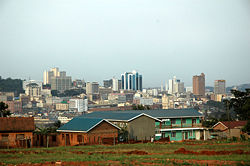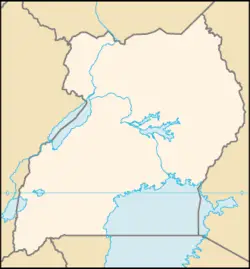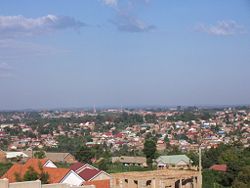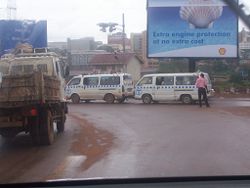Kampala
| Kampala, Uganda | |
| Kampala, Uganda | |
| Map of Uganda showing the location of Kampala. | |
| Coordinates: 0°19′N 32°35′E | |
|---|---|
| Province | Kampala (district) |
| Area | |
| - Total | 189 km² (73 sq mi) |
| - Land | 176 km² (68 sq mi) |
| - Water | 13 km² (5 sq mi) |
| Elevation | 1,190 m (3,904 ft) |
| Population (2002 est.) | |
| - Total | 1,208,544 |
| Time zone | EAT (UTC+3) |
Kampala is the capital city, and largest city, of Uganda, and is coterminous with the district of Kampala.
Geography
The name Kampala derives from the British name for the area the hills of the Impala. Translated to Luganda it became "kasozi ka Impala". With time, local usage took to referring to the hunting expeditions of Kabaka, the King of Buganda, as "Kabaka agenze e ka´empala ("The Kabaka has gone to Ka'mpala"). Eventually the hills became known as Kampala.[1]
Kampala occupies a series of hills at an elevation of about 3900 feet (1190 meters) and is located in the south of the country, north of Lake Victoria.
Kampala enjoys a mild equable climate due to its altitude and the cooling breezes from the mountains, even though it is located a little north of the equator. The average maximum daytime temperature in January of 82°F (28°C), dropping to an average maximum of around 77°F (25°C) in July. There are two distinct rainy seasons; the first is during the months of March and May and the second during the months of September and November. Mean annual precipitation is 46.22 inches (1174mm).
Like many cities, Kampala is said to be built on seven hills, although this isn't quite accurate.
- Kasubi Hill is where the Kasubi Tombs of the previous Kabakas are housed.
- Mengo Hill where the present Kabaka's Palace is and the headquarters of the Buganda Court of Justice.
- Kibuli Hill is home to the Kibuli Mosque. Islam was brought to Uganda before the Christian missionaries came.
- Namirembe Hill is home to the Namirembe Protestant Cathedral. The Protestants were the first of the Christian Missions to arrive.
- Rubaga Hill, where the Rubaga Catholic Cathedral is, and was the headquarters of the White Fathers.
- Nsambya was the Headquarters of the Mill Hill Mission. It now houses Nsambya Hospital.
- The little hill of Kampala, from which the city got its name, is where the ruins of Lugard's Fort were until 2003, when they were destroyed to make way for a 15,000-seater mosque.
The city spread to Nakasero Hill where the administrative centre and the wealthiest residential area is. Tank Hill has a water tank, Mulago Hill has Mulago Hospital, the largest hospital in Uganda, and Makerere Hill is where Makerere University is situated.
The city is now rapidly expanding along both sides of the Makindye Hill and Konge Hill.
Hospitals include Kibuli Hospital, St Francis Nsambya and the International Hospital (IHK). Philanthropic health services are provided by Hope Clinic Lukuli situated between Makindye/ Konge and Tank Hills.
Suburbs include Kololo in the East on Kololo Hill the highest hill, home to the Uganda Museum; Namirembe; Kibuli; Kabalagala; Rubaga; Ntinda; Najjera; Kisassi; Nateete; Kireka; Namugongo; Najjanakumbi among others.
History
Before the arrival of the British, Mutesa I the Kabaka (king) of Buganda had chosen the area that was to become Kampala as one of his favourite hunting grounds. The area was made up of numerous rolling hills and lush wetlands. It was an ideal breeding ground for various game, particularly a species of antelope, the Impala (Aepyceros melampus).
The city grew as the capital of the Buganda kingdom, from which several buildings survive, including the Kasubi Tombs (built in 1881), the Buganda Parliament, the Buganda Court of Justice and the Naggalabi Buddo Coronation Site.
In 1890, Frederick Lugard constructed a fort for the British East Africa Company. Kampala grew up around that fort. In 1962, Kampala replaced Entebbe as the national capital.
Severely damaged in the Uganda-Tanzania War (1978-1979), which led to the overthrow of Idi Amin Dada's regime.
The city has since then been rebuilt, with construction of new buildings including hotels, banks, shopping malls, educational institutions, hospitals and improvement of war torn buildings and infrastructure.
Traditionally, Kampala was a city of seven hills, but overtime it has come to have a lot more.
Government
Uganda is a republic in which the president, who is both chief of state and head of government, is elected to serve a five-year term. The unicameral National Assembly comprises 332 members, of which 215 are elected by popular vote, 104 are nominated by legally established special interest groups [women 79, army 10, disabled five, youth five, labor five], as well as 13 ex officio members, all to serve five-year terms.
The city is divided into five boroughs that oversee local planning: Central, Kawempe, Makindye, Nakawa and Rubaga.
Economy
Uganda has substantial natural resources, including fertile soils, regular rainfall, and sizable mineral deposits of copper, cobalt, gold, and other minerals. Agriculture is the most important sector of the economy, employing over 80% of the work force. Coffee accounts for the bulk of export revenues.
Per capita GDP was estimated at $1000 in 2007.
Kampala is also home to the headquarters of the East African Development Bank.
Tourism Manufacturing
Uganda's roads, which are of variable quality, radiate from Kampala, although the network is sparse in the north
Cologne's international airport is Cologne Bonn Airport, also called Konrad Adenauer Airport. The Rhine harbor is one of the larger inland ports in Germany. Public transport within the city includes buses, a subway system, and the Rheinseilbahn aerial tramway crossing the Rhine. Cologne has pavement-edge cycle lanes linked by cycle priority crossings.
In early 2007, it was announced that Kampala would remove commuter taxis from its streets and replace them with a comprehensive city bus service, [citation needed] which will also cover the greater Kampala metropolitan area including Mukono, Mpigi, Bombo, Entebbe, Wakiso and Gayaza. The decision is yet to be implemented. Boda-bodas -local motorcycle transportation are a popular mode of transport that gives access to many areas with in and outside the city. Standard fees for these range from UGX 500 to 1000 or more. They are quite handy for those who do not want to be stuck in traffic for long. Passengers always need to ask the rider to slow down or rather take it slow so as to avert any accidents. [citation needed]
The Kampala City Council will introduce a congestion fee of sh30,000 per vehicle per day when the bus network is implemented.[2] This decision is also yet to be implemented.
Demographics
With a population of 1,208,544 (2002)[3]
Race/ethnicity - historical background of ethnic groups Language Religion Colleges and universities The main campus of Makerere University, one of East and Central Africa's premier institutes of higher learning, can be found in the Makerere Hill area of the City.
Kampala has a diverse ethnic population, although the Baganda - the local tribe make up over 60% of the Greater Kampala region. The city's ethnic make up has been defined by political and economic factors. During the rule of Milton Obote and Idi Amin in the 1960s, 70's and 80's who were both from northern Uganda, a significant number of northern Ugandans moved into Kampala. Most served in the armed forces and the police. Most settled around the areas where the Military and Police barracks were located - Naguru, Bugolobi and Mbuya. With the overthrow of Milton Obote in 1986, many northern Ugandans fled the city. At the same time a large number of western Ugandans (particularly the Banyankole) moved in reflecting the large proportion of western Ugandans in the new government of Yoweri Museveni.
The mismanagement of Uganda's economy during the 1970s and 1980's meant that there were fewer employment opportunities outside Kampala. This encouraged many people from around the country to move into the city, and most have not moved back to their home districts after the revitalization of the economy in the 1990s.
Inter-tribal marriage in Uganda is still rare, and although many Kampala residents have been born and bred in the city they still define themselves by their tribal roots. This is more evident in the suburbs of the city, where local languages are spoken widely alongside English, Swahili and Luganda. Apart from the Baganda and Banyankole, other large ethnic groups include the Basoga, Bafumbira, Batoro, Bakiga, Alur, Banyoro, Iteso and Acholi.
Of interest
Other features of the city include the Ssezibwa Falls, Ugandan National Theatre, St. Balikuddembe Market (formerly Owino Market) and Nakasero Market. Kampala is also known for its nightlife, which includes a casino. Entebbe International Airport is located at Entebbe, 35 km (22 miles) away, while Port Bell on the shore of Lake Victoria is 10 km (7 miles) away.
Also to note is that Kampala hosts one of only seven Bahá'í Houses of Worship in the world. It is known as the Mother Temple of Africa and is situated on Kikaya Hill on the outskirts of the city. Its foundation stone was laid in January 1958, and was dedicated on January 13, 1961. See Bahá'í Faith in Uganda.
ReferencesISBN links support NWE through referral fees
External links
- Encyclopaedia Britannica Kampala Retrieved December 9, 2008.
- World Fact Book 2008 Uganda Retrieved December 9, 2008.
- African Cities.net Kampala Retrieved December 9, 2008.
- Kampala City council Website
- Kampala Online - Website about Kampala
- Kampala Street Map
Coordinates:
| |||||||||||||
Credits
New World Encyclopedia writers and editors rewrote and completed the Wikipedia article in accordance with New World Encyclopedia standards. This article abides by terms of the Creative Commons CC-by-sa 3.0 License (CC-by-sa), which may be used and disseminated with proper attribution. Credit is due under the terms of this license that can reference both the New World Encyclopedia contributors and the selfless volunteer contributors of the Wikimedia Foundation. To cite this article click here for a list of acceptable citing formats.The history of earlier contributions by wikipedians is accessible to researchers here:
The history of this article since it was imported to New World Encyclopedia:
Note: Some restrictions may apply to use of individual images which are separately licensed.






